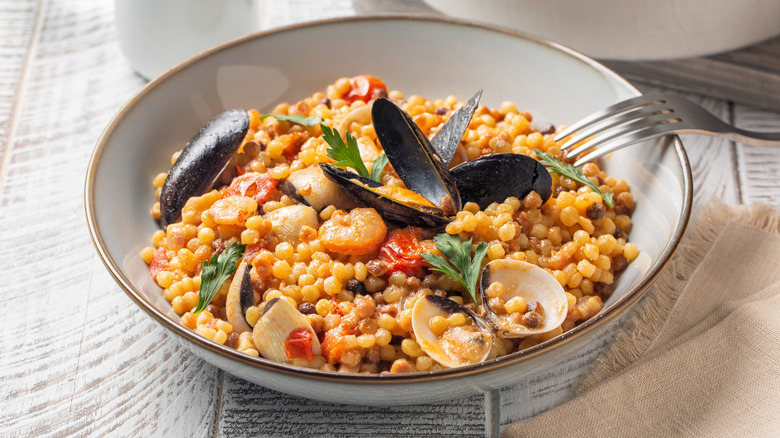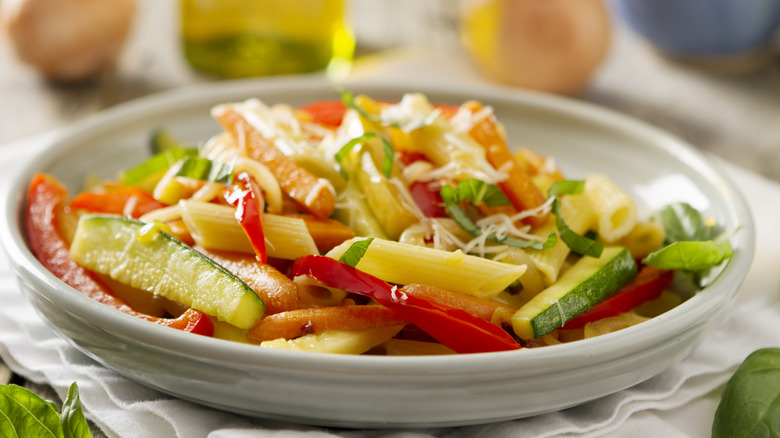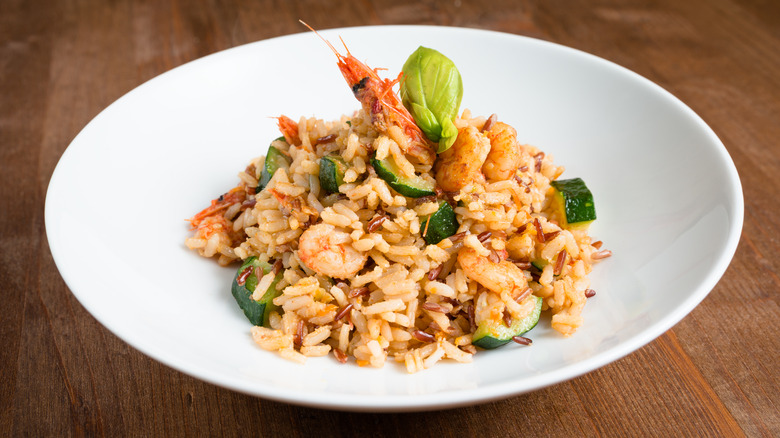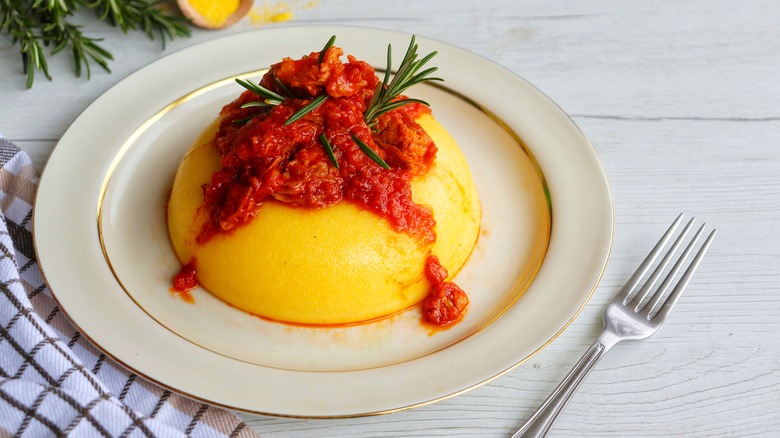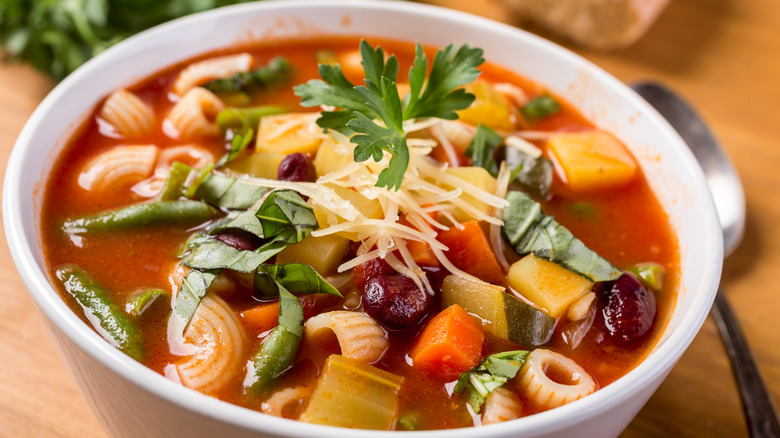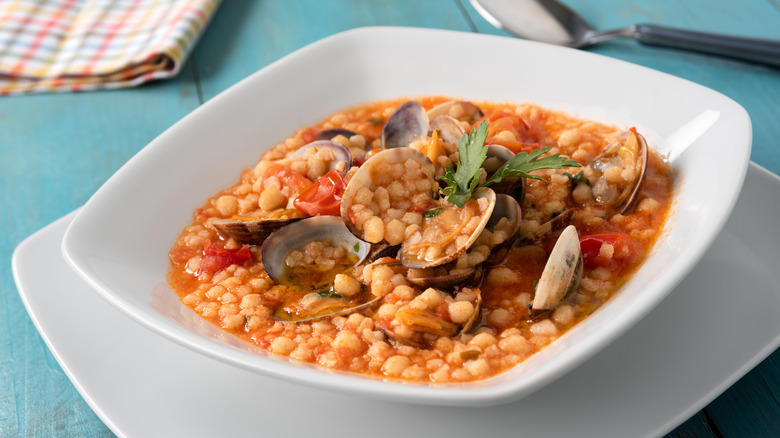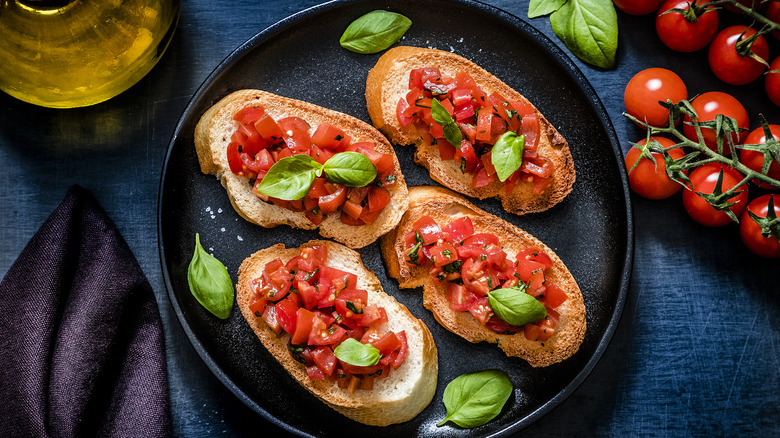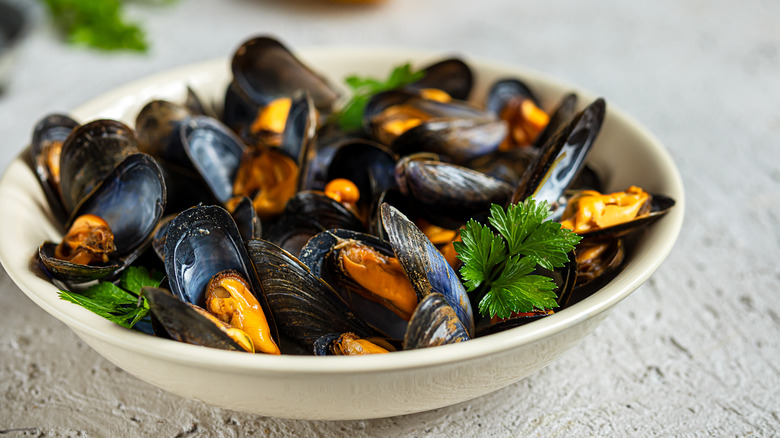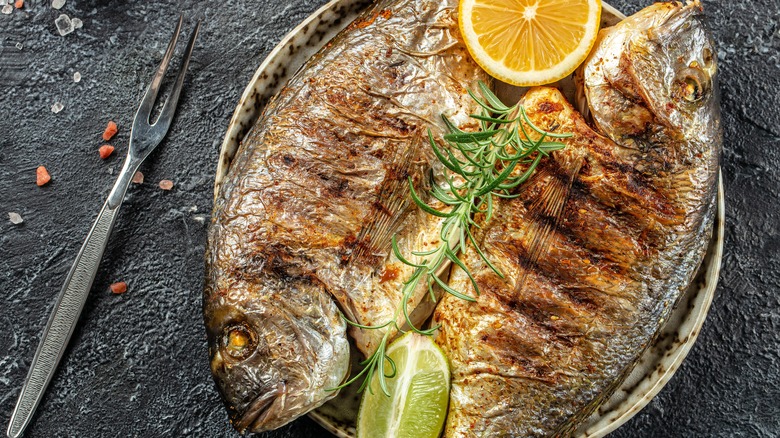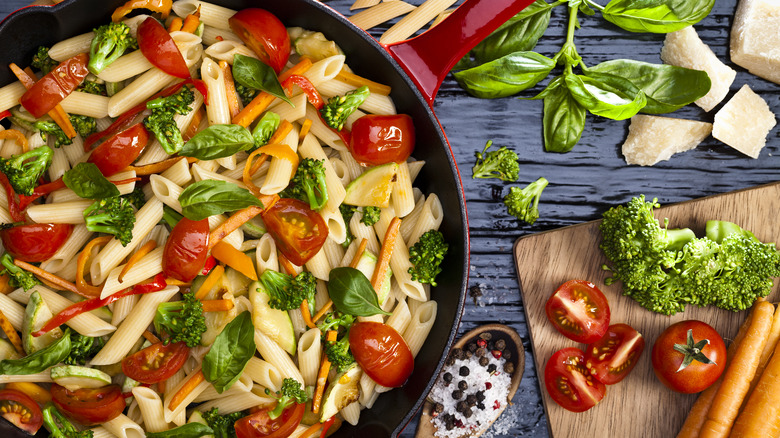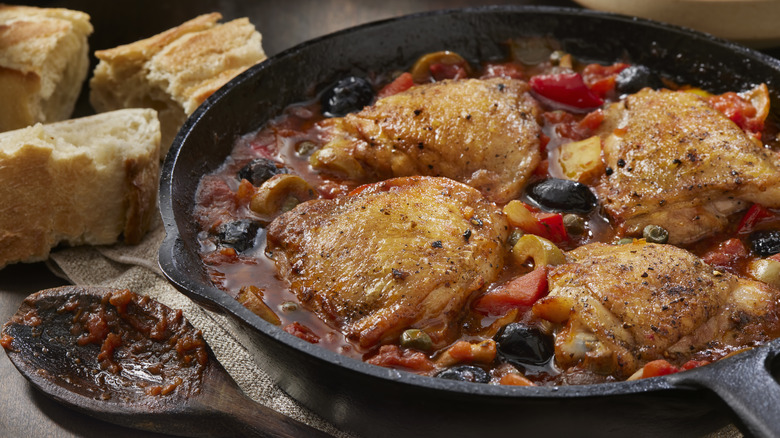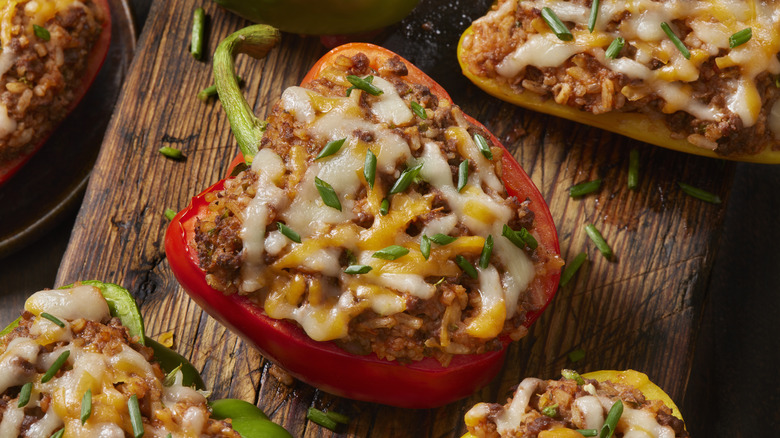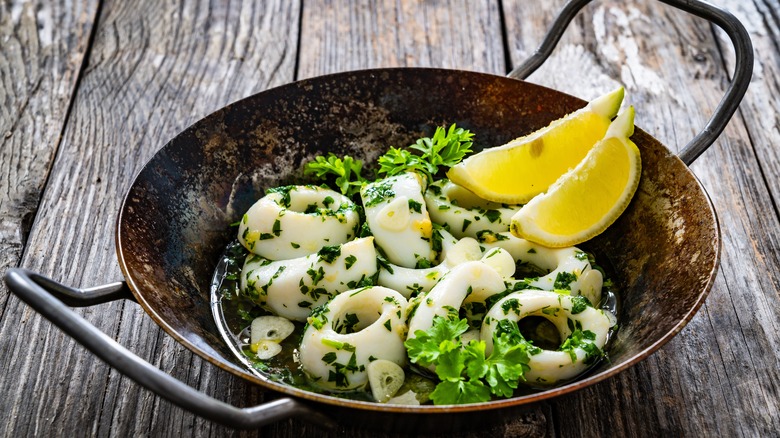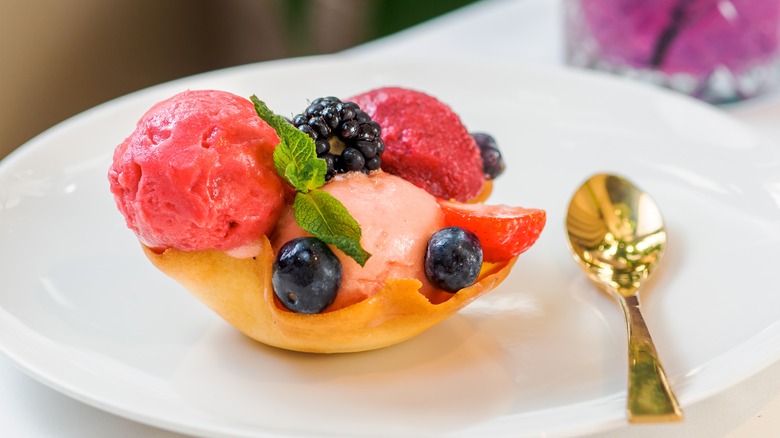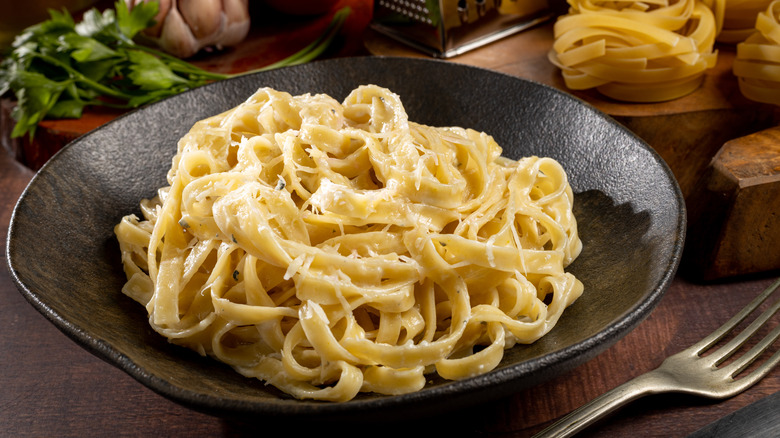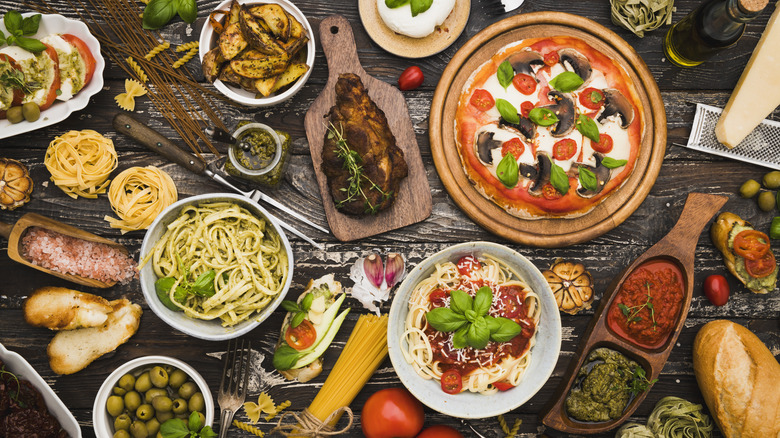12 Healthy Meals To Order At An Italian Restaurant
Making your own meals at home can be a great way to save money, but it can get tiring sometimes. You deserve to take a night off or two every once in a while. Heading over to your local Italian restaurant would be a fantastic option, but the dishes can be quite heavy. If you're trying to eat healthier, it may be frustrating staring at the menu, saying "no" to everything you see.
But just because you're being health-conscious doesn't necessarily mean you have to sit out on tasty Italian cuisine. As a foodie with a biology degree, I've taken a look at the ingredients in popular menu items to determine which can acceptably fulfil our nutritional needs without clogging our arteries too much. You can read more about how I chose at the end of the article, but for now, here are several healthy Italian dishes to consider ordering at a restaurant.
1. Pasta primavera
If you're craving pasta, then you might be tempted to go for some creamy goodness, like fettuccine Alfredo. However, not only is it high in saturated fat, but it has a fair bit of cholesterol and sodium, too. A much better alternative is pasta primavera, which has the feel of a hearty pasta dish but without all the carbs.
For one, the sauce is made of chicken broth, so you still have liquid for your pasta. Don't worry about missing out on cheese, though, as pasta primavera is typically tossed in and topped with parmesan cheese. This type of cheese is surprisingly healthy for you; not only is it lactose-free, but it's also low in fat and chock full of protein. A single ounce has 10 grams of protein, which is around 20% of what you need in a day, typically. Add in some salt and pepper and then top with basil, and pasta primavera is a refreshing yet light dish.
The plate is also a visual feast for your eyes. Pasta primavera consists of lightly cooked seasonal vegetables, such as bell peppers, zucchini, yellow squash, snow peas, broccoli, and carrots. Needless to say, you'll get a decent serving of veggies in this meal, which will help your body stock up on essential vitamins and minerals.
2. Shrimp and zucchini risotto
Risotto might seem creamy and indulgent, but it's not actually all that bad for you. The beauty of risotto is that its thick and silky texture comes from the starch released from Arborio rice during cooking, not from a heavy dairy-based sauce. This means that instead of relying heavily on cheese, milk, or heavy cream to flavor risotto, chefs use stock instead.
If you don't like plain risotto, then choose the version with shrimp and zucchini in it. The shrimp gives you a flavorful hint of the sea, especially when cooked with garlic. Not only are shrimp low in calories and fat, but they're also packed with protein; a 3-ounce serving provides you with 20 grams of it. The zucchini allows you to get your greens in during dinner, and its mild taste makes it easy to go down. The bonus is that 1 cup of it gives you 40% of your daily recommended vitamin A intake and 14% for vitamin C.
3. Polenta with marinara sauce
Polenta is similar to grits but not quite the same. On its own, polenta is already quite healthy, and it's a fantastic alternative to pasta if you want something lighter. It's made of ground cornmeal, meaning it's gluten-free. It's low in calories and fat, and you'll find plenty of antioxidants in polenta, which can fight against aging and diseases. It's also rich in dietary fiber, meaning it'll be easier to resist snacking between meals. Just make sure you stay away from fried polenta, as the oils used for both pan and deep-frying will add fat and calories.
Admittedly, polenta on its own can be a little boring. If the novelty of plain polenta has worn off for you already, then try it with some marinara sauce. Not only does the sauce give the dish a nice acidic kick, but it makes it not so dry, too. In addition, consuming marinara sauce is essentially the same as getting a serving of veggies since you'll get over 20% of your daily vitamin A and E needs in one go. Do note that it can be high in sodium, so if you're watching your salt intake, it's okay to leave some marinara sauce behind on your plate.
4. Minestrone
Some people like to have soup as a meal, especially if it's cold and rainy outside. There's nothing better for warming up your chilly bones than sipping on a piping hot bowl of loaded liquid. And there's nothing better for this job than minestrone; it's not a thin broth that won't fill you up.
The good news is that it's not all junk, either. The beauty of minestrone is that it's very versatile, as restaurants will use whatever meats and vegetables are available; if you stick to a plant-based diet, there are equally delicious vegetarian versions available, too. Whether meat is included or not, the soup is filled with veggies, such as celery, carrots, and zucchini, which can easily help you meet your daily required intake. This ensures that your body gets the vitamins and minerals needed to be strong and healthy.
What makes this soup so filling and satisfying are the beans. Legumes are heavyweights in fiber and protein, meaning that even if you have a small bowl of minestrone, you probably won't be hungry until it's time for your next meal. The soup also has pasta pieces, which can be filling if you choose correctly. Whole grain-pasta is rich in fiber, so opt for that if possible.
5. Fregula with clams
Fregula (often written incorrectly as "fregola") is a couscous-like pasta from Sardinia. It comes in the form of small balls and is made from semolina, which is made from durum wheat. While this unfortunately means there's gluten in the pasta, it's still very healthy for those who can eat it, especially since it's baked in the oven before boiling for consumption. This is yet another ingredient that's high in protein and fiber, so you can count on fregula to make a gratifying meal.
Typically, this pasta is simmered in a tomato sauce. This fact alone makes it a healthier choice when compared to pasta dishes with white sauce, as there's no heavy cream. Also, shellfish (like clams) are high in omega-3 fatty acids, which can improve brain and heart health. They're low in calories yet offer a rich vastness of nutrients such as iron, magnesium, vitamin B12, and, most abundantly, zinc. Clams provide a nice saltiness without overloading the fregula since they're steamed and not breaded or fried.
6. Bruschetta
Bruschetta is typically eaten as an appetizer, but if you aren't feeling up to loading up on pasta, these bread slices can be a meal on their own. This is especially true when you consider that Italian restaurants have various types of bruschetta, so you can always order different dishes and mix them up for an interesting time. And because they come as individual slices, it's easy to share this order with others.
Bruschetta might seem like a simple menu item, but don't let that fool you. The base is a crusty ciabatta bread made with whole wheat flour, providing you with fiber and helping to make you feel full for longer. On top, you'll often find tomatoes, parmesan cheese, garlic, and basil. Not only are tomatoes juicy, sweet, and delicious, but the antioxidants within can lower your risk of cancer and type 2 diabetes. Parmesan cheese is low in fat and doesn't have carbs, either. Lastly, bruschetta uses olive oil instead of butter, and olive oil is high in healthy monosaturated fats and antioxidants.
7. White wine mussels in aromatic herbs
Shellfish is prominently featured in Italian cuisine, and it can be a breath of fresh air after gorging yourself on pasta and pizza dishes. If you're tired of hefty carbs and crave something delicious that doesn't leave you couch-locked for hours afterward, then look under the "Seafood" section on the menu.
An outstanding shellfish option is white wine mussels in aromatic herbs. Herbs are always the key to upgrading dishes from bland and boring to tantalizing for the taste buds, so you can't go wrong here. What's awesome is they enhance flavors while offering health benefits such as fighting inflammation and lowering cholesterol levels. As for the main star, they're steamed with a small amount of olive oil and butter, so the dish isn't very fatty. Mussels are also packed with protein, vitamins, and minerals while remaining relatively low in calories. Plus, when cooked correctly, mussels are served with their shells open, so you don't have to deal with messy peeling like you would with things like shrimp.
8. Grilled sea bream (orata)
Eating fish is outstanding for your health since it's rich in omega-3 fatty acids, which can lower your risk of heart attacks and strokes. In addition, it's high in protein and contains very few calories. For those who aren't adventurous eaters, white fish are ideal, as their taste is milder and not so overwhelming. While white fish aren't as filled with nutrients and vitamins, they're still a great source.
One excellent dish to order at an Italian restaurant is grilled sea bream, or orata. Not only does the fish have a rich flavor, but its meat is pretty juicy, too. More importantly, this menu item is grilled instead of fried, and there's no breading, either. The fish is lightly coated with olive oil and often seasoned with tomatoes, rosemary, and garlic. It's a healthy and incredibly aromatic dish to feast on. And even better is that it's an easy plate to split.
9. Pasta all'Ortolana
Think the opposite of "creamy pasta," and you've got pasta all'Ortolana. Not only is it free of heavy cream, but there's no cheese, which makes it perfect for those who are lactose intolerant. And you won't have to worry about having a food coma and an overstuffed belly, either; this is the ideal menu item for those who want to eat light.
What's striking about this Italian dish is its abundance of vegetables. In fact, in lieu of fatty cheeses and meat ragùs, pasta all'Ortolana features a veggie sauce made by cooking down greens such as eggplants, carrots, onions, peppers, and garlic. The lack of meat means this is a good choice if you're a vegetarian but still love pasta. It's also terrific if you're not a fan of veggies but still want to get your daily recommended intake. Restaurants will pick the freshest vegetables to make a tasty combination. Some may even upgrade their sauce by adding tomato passata, a type of puree made from late-summer tomatoes that gives any recipe a fresh flavor that's hard to resist.
10. Chicken cacciatore
"Cacciatore" is the Italian word for "hunter," so you can see why this menu item is often referred to as "hunter's stew." During the Renaissance era, hunters cooked it with whatever they could track down, which was usually rabbit or wild game. But today, we have the luxury of whipping up cacciatore with whatever protein we wish. As a result, we see different recipes using meats such as rabbit, salami, and lamb.
The healthiest option out of all these meats is chicken, since it doesn't have much fat and packs plenty of protein. While dark meat is softer and tastier, it does have more fat and calories, especially if you're eating thigh meat with its skin on. So if you're really watching what you eat, the best choice is skinless white meat.
Otherwise, chicken cacciatore is often prepared with tomatoes, bell peppers, carrots, onions, and herbs. Olives are scattered on top to give you the right balance of mouth-puckering sourness and sweetness. Don't pick those off, as both black and green olives can give you a dose of healthy fats and fiber.
11. Stuffed peppers
Bell peppers are central to Italian cooking, and you'll usually see them diced up in sauces or toppings. However, because this vegetable is so versatile, you'll also see it cut in half and stuffed with a mixture of beefy goodness. While beef admittedly isn't the best type of meat for your health (red meats in general aren't as great), the relatively small amount in Italian stuffed peppers is acceptable, especially when you weigh the benefits of everything else inside.
First of all, the bell pepper shell checks off your body's needs for vitamin C, not to mention carotenoids and other antioxidants. It has a decent amount of fiber as well. As for the filling, you'll typically see ground beef, tomatoes, and rice. If you're lucky, your restaurant will use brown whole-grain rice, which is a more wholesome alternative to white rice since it has more fiber, antioxidants, vitamins, and minerals. Some places will also utilize fresh vegetables such as spinach, which will help you hit your quota for iron intake.
12. Grilled calamari with lemon
Those who love seafood may be tempted to go for fried calamari. Breaded squid rings that have been deep-fried to perfection and served with delectable dipping sauces are simply irresistible. However, fried food can be loaded with trans fats, which increase your risk of things like heart disease and cancer. The dipping sauce may be full of calories and sodium as well.
The better alternative is to choose grilled calamari and say "no" to the dipping sauces; a squeeze of lemon juice on top will add acidity and an interesting zing for your taste buds. Grilling is a smarter choice than deep-frying since there's significantly less oil used, and it tastes just as good. And because this calamari doesn't have breading, it scores more points in the healthy Italian seafood department alongside amazing flavor. Squid is rich in vitamin C, iron, and calcium, making it a tasty way of getting those vitamins and minerals.
Healthiest desserts to order at an Italian restaurant
It's customary to order dessert at the end of your meal to round out everything. But those who need to watch their food intake for health reasons may be discouraged by their menu options and sit it out instead. However, you deserve to have a small treat; you're dining out, after all, and surely there must be suitable choices that aren't too overindulgent. The good news is, there are.
For instance, you don't have to stare wistfully at your table mates' bowls of gelato. Opt for sorbet, which is dairy-free and cuts out a lot of the heaviness. It's made from water, sugar, and fruit puree, so it tastes good but is low in calories. Or if it's too cold for frozen desserts, a fresh fruit plate is awesome as well. It's simple yet tasty, and it's traditionally eaten after Italian meals anyway. Fruits are low in calories and rich in vitamins, and they give you something sweet without overdoing it.
If you absolutely must have a decadent dessert, then your best pick would be panna cotta. This is a cold custard made from sweetened cream and gelatin, and it's generally served with a caramel sauce, so it's best if you split it. However, if you choose a fruit-flavored panna cotta, it'll give you added sweetness without added sugar. Ordering without the caramel sauce will cut the carb content by about half.
Dishes to avoid if you're trying to eat healthier
We've discussed the healthiest dishes to order at an Italian restaurant, but what about the ones you should avoid? Knowing the biggest offenders to cross off the list will make it easier for you to make smarter decisions when put on the spot.
First up on our list are creamy pasta dishes, such as fettuccine Alfredo and carbonara. These are made with heavy cream, cheese, and butter, all of which are high in calories, saturated fat, and cholesterol. Next are deep-dish pizzas; thick crusts mean more carbs, and the cheeses will push the calorie count to the high heavens. And if you add meat, that's even more calories and fat. Lastly, avoid ordering cannoli as a dessert. Not only is it deep-fried, but it's filled with ricotta cheese and sugar. Ricotta cheese is high in saturated fat, which can increase your risk for heart disease.
Methodology
To determine which dishes to include, I went through Italian restaurants' menus and checked their ingredients against reputable health and science sites. Not only do I have a bachelor's degree in biology (which helps me digest scientific information), but Italian food is a favorite of mine. As someone who's had to watch what I eat due to health reasons, I've learned to have a discerning eye to pick out nutritious yet tasty dishes.
